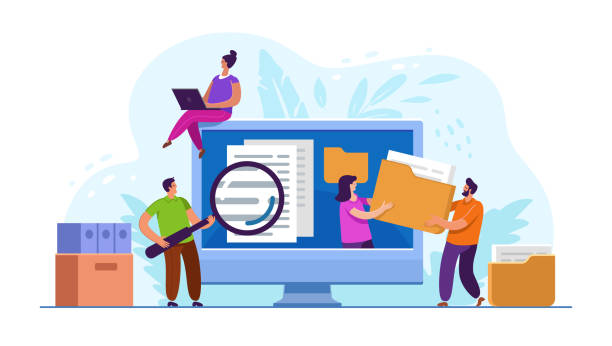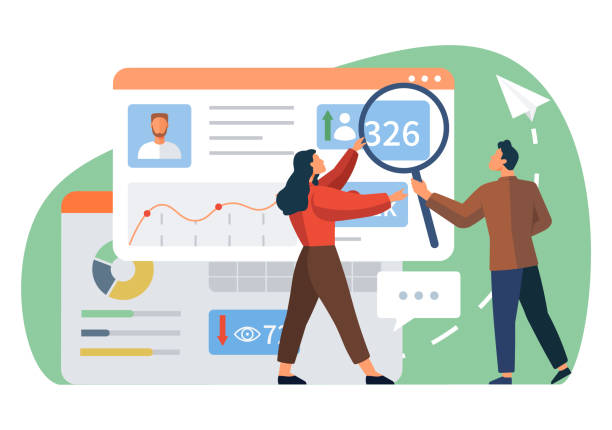Introduction to Secure Website Design: Importance and Necessity

In today’s digital world, where personal and business information is increasingly going online, #Secure_Website_Design is no longer an option, but a vital necessity.
This process involves a set of preventive and defensive measures taken to protect websites from cyber attacks and maintain the integrity, confidentiality, and availability of data.
The importance of secure website design not only helps maintain a business’s reputation and credibility but also prevents unauthorized access to sensitive user information.
With the increasing complexity of cyber threats, from phishing and malware attacks to SQL injection and XSS, developers and website administrators must prioritize security from the earliest stages of design and development.
Ignoring the principles of secure website design can have irreparable consequences, including data loss, theft of customer information, service disruption, and heavy legal fines.
For example, a security flaw could lead to your website being identified as a source for spreading malware or users’ banking information being stolen.
Therefore, investing in website security is not an additional cost, but a form of insurance for your digital future.
In this explanatory article, we will comprehensively explore various dimensions of secure website design and provide practical solutions for building a secure and reliable online platform.
This proactive approach is the foundation of any online platform seeking sustainability and success in the web space.
Do you have an online store but your sales are not as expected? RasaWeb solves your problem forever with professional e-commerce website design!
✅ Significant increase in conversion rates and sales
✅ Unparalleled user experience for your customers
⚡ Click to get free consultation from RasaWeb!
Familiarity with the Most Common Web Vulnerabilities and How to Counter Them

Understanding common web threats and vulnerabilities is the first step towards effective secure website design.
Websites are constantly targeted by various attacks, each of which can lead to security breaches, unauthorized data access, or service outages.
Among the most common vulnerabilities is SQL Injection; in this attack, the attacker injects malicious SQL code through user inputs to gain access to the database or manipulate information.
Countering this threat requires the use of Prepared Statements and rigorous input validation.
Another vulnerability is Cross-Site Scripting (XSS), where malicious JavaScript code is executed in the victim’s browser.
This can lead to cookie theft, session hijacking, or alteration of website content.
To prevent XSS, all user inputs must be properly sanitized and outputs encoded.
Also, Cross-Site Request Forgery (CSRF) is another common attack where an attacker tricks a user into sending an unintended request to a legitimate website without their knowledge.
Using CSRF tokens and validating the origin of the request can neutralize this attack.
Specialized knowledge of these vulnerabilities and the implementation of appropriate defensive mechanisms are key components in the process of secure website design.
In addition, flaws in session management, weak encryption, and incorrect server configurations can also open doors to attackers, all of which must be considered within a comprehensive strategy for securing the site.
Best Practices for Secure Development of Your Website
![]()
To ensure secure website design and stability, adopting best practices for secure development from the earliest stages of the software development lifecycle is crucial.
This educational approach emphasizes design and coding processes that minimize vulnerabilities.
One of the most important principles is the “Principle of Least Privilege”; meaning that each part of the system or user is given only the minimum access necessary to perform its task.
This prevents the spread of vulnerabilities in case of a breach in one section.
Input Validation is another essential step.
Any data entered into the system by the user must be carefully checked to ensure it matches the expected format and to prevent the entry of malicious code.
This includes checking data type, length, format, and content.
Using prepared statements in database queries to prevent SQL injection, as well as proper encoding of outputs to counter XSS, are among the key techniques in this area.
Furthermore, proper error and log management is of high importance.
Generic error messages instead of detailed information can prevent the disclosure of sensitive system information.
Regular and secure logging of system activities also helps in tracking attacks and identifying weaknesses.
Finally, using secure libraries and frameworks, and continuously updating them, ensures that you benefit from the latest security solutions.
These fundamental measures form the backbone of secure website design and help developers build systems resilient to cyber threats.
| Security Stage | Description | Key Point in Secure Website Design |
|---|---|---|
| Input Validation | Strict control of user input data to prevent code injection. | Implement validation on both server and client sides. |
| Session Management | Generate strong and secure session tokens, and properly invalidate them. | Use HTTPS for all sessions. |
| Error and Logging Management | Display generic error messages and accurately log security events. | Prevent disclosure of sensitive system information in error messages. |
| Encryption | Use strong encryption protocols to protect data. | Implement TLS/SSL for communications and encrypt sensitive data. |
Securing the Server and Website Hosting Infrastructure

In addition to the website code, the environment on which the website is hosted also plays a vital role in secure website design.
Securing the server and infrastructure is a key guiding component for protecting the entire website ecosystem.
The first step is to choose a reputable and secure hosting provider that has a strong commitment to security and offers security features such as advanced firewalls, Intrusion Detection/Prevention Systems (IDS/IPS), and regular backups.
After selecting a host, secure server configuration becomes important.
This includes regularly updating the operating system, web server (such as Apache or Nginx), and other software used to fix known vulnerabilities.
Disabling unnecessary services and ports, as well as blocking unauthorized access to the server, helps reduce the attack surface.
Using network and host-based firewalls to control incoming and outgoing traffic and prevent unauthorized access is essential.
Also, careful management of access and file/directory permissions is very important.
Only grant necessary permissions to files and folders that require access, and strictly avoid using “777” permissions.
Implementing comprehensive logging mechanisms and continuous monitoring of server logs to identify suspicious activities is also of high importance.
Installing and configuring security tools such as malware scanners and antivirus software, and running them regularly, helps detect and remove threats before they cause damage.
Finally, performing regular and tested backups of all server data and configurations ensures that in the event of any security incident, the website can be quickly restored and damages minimized.
These measures together provide a secure environment to support secure website design.
Are you tired of losing business opportunities due to not having a professional corporate website?
RasaWeb, with its professional corporate website design, helps you:
✅ Build a powerful and reliable image for your brand
✅ Convert website visitors into loyal customers
⚡ Get a free consultation now!
The Importance of Data Encryption and Security Protocols (SSL/TLS)

Data encryption is the backbone of secure website design and protecting user privacy in the online space.
In the digital age, where the exchange of sensitive information such as financial details, personal information, and health data increasingly takes place via the web, the security of this data is of paramount importance.
SSL (Secure Sockets Layer) protocols and its successor, TLS (Transport Layer Security), serve as the gold standards for encrypting communications between a user’s browser and the web server.
When a website uses an SSL/TLS certificate, communications between the user and the server are encrypted, which prevents eavesdropping, tampering, or forgery of information by third parties.
These protocols ensure the confidentiality and integrity of data by establishing a secure communication channel.
The presence of “HTTPS” at the beginning of the website address and the display of a lock icon in the browser’s address bar indicate the use of these protocols and the website’s commitment to secure website design.
Google and other search engines also give higher ranking priority to HTTPS websites, which itself contributes to the site’s credibility and visibility.
In addition to in-transit encryption with SSL/TLS, at-rest data encryption is also very important for protecting information stored in databases and servers.
This involves encrypting disks, files, and sensitive fields in the database.
An analytical approach to data security shows that for a comprehensive secure website design, both types of encryption must be implemented.
Lack of proper encryption can lead to catastrophic security breaches, as many examples of user data disclosure due to neglecting this principle have been observed.
Choosing strong encryption algorithms, secure management of encryption keys, and regular updates of SSL/TLS certificates are all vital components of this strategy.
User Authentication and Authorization Management

User authentication and authorization management is another pillar in the architecture of secure website design.
These two concepts ensure, respectively, who has access to the system (authentication) and what they can do (authorization).
Implementing strong authentication mechanisms, such as using complex passwords and password expiration policies, is the first step.
Users are encouraged to use long passwords, a combination of uppercase and lowercase letters, numbers, and symbols.
Password storage should also be hashed using strong algorithms and with Salt to prevent dictionary and brute-force attacks.
Educational point: Using Two-Factor Authentication (2FA) or Multi-Factor Authentication (MFA) adds a critical layer of security.
These methods, in addition to the password, require another authentication factor such as a code sent to a mobile phone, a fingerprint, or a hardware token.
This makes unauthorized access difficult even if the password is compromised.
After authentication, it’s time for authorization management.
This includes defining user roles (e.g., administrator, editor, regular user) and assigning specific access rights to each role.
For example, a regular user should not have access to the website’s admin panel.
This principle ensures “least privilege,” meaning each user only has access to the resources and functionalities necessary to perform their tasks.
Implementing Role-Based Access Control (RBAC) is an effective method for managing permissions at scale.
Continuous monitoring of user activities and identification of suspicious behavioral patterns can also help in early detection of intrusion attempts.
Ignoring these principles can lead to compromised user accounts and unauthorized access, which will negatively impact the overall secure website design of the system.
The Importance of Regular Security Reviews and Penetration Testing

In the ever-changing world of cyber threats, secure website design is not a static process, but requires continuous review and updates.
Conducting regular security reviews and Penetration Testing is of paramount importance.
These measures act as medical check-ups for your website, identifying weaknesses and vulnerabilities that may have arisen over time or after updates.
Regular security reviews include automated vulnerability scans that check website software and configurations for known issues.
These scans can be performed periodically or after any significant change in code or infrastructure.
However, for a comprehensive and deeper understanding of the security posture, penetration testing is essential.
In penetration testing, cybersecurity experts (known as “ethical hackers”) attempt to penetrate the system using methods and tools similar to real attackers.
Their goal is to identify vulnerabilities that automated scanners might miss, such as logical flaws in the code or a chain of small vulnerabilities that together could lead to a major breach.
The results of penetration testing provide a comprehensive report of discovered vulnerabilities, their risk level, and practical solutions for remediation.
This information is invaluable for the development team to fix weaknesses before they are exploited by real attackers.
Performing these tests regularly (e.g., annually or after each major update) and also after any significant changes to the website’s architecture or functionalities, is crucial for maintaining secure website design.
This proactive approach helps your website always stay one step ahead of threats and protects your data and reputation.
| Type of Security Test | Objective | Suggested Frequency |
|---|---|---|
| Vulnerability Scan | Automated identification of known vulnerabilities in code and configuration. | Weekly or monthly, and after any minor change. |
| Penetration Test (Pen Test) | Simulate real attacks to discover deep and logical vulnerabilities. | Annually or after each major update. |
| Secure Code Review | Manual and automated review of source code to find security flaws. | During development phases and after implementing new features. |
| Security Configuration Assessment | Review security settings of server, database, and software. | Quarterly and after any infrastructure change. |
Incident Response and Disaster Recovery Strategies

Even with the best secure website design and adherence to all preventive principles, the possibility of a security incident is not zero.
Therefore, having a comprehensive Incident Response Plan and Disaster Recovery Plan is essential for any website.
These plans enable businesses to react quickly and effectively in the event of a security breach or system failure, minimize damage, and restore services.
This is a specialized aspect of cybersecurity that should not be overlooked.
The incident response plan should include specific steps for incident identification, containment, eradication, system cleanup, and finally, recovery.
This plan should define responsible teams, roles and responsibilities, communication protocols (internal and external), and necessary tools.
For example, after identifying an intrusion, the team should be able to quickly block the attacker’s access, identify the source of the intrusion (e.g., a specific vulnerability in the code), and then clean the system and fix the weaknesses.
Concurrently, the disaster recovery plan focuses on maintaining business continuity in the event of natural disasters, widespread cyber attacks, or system failures.
This plan includes strategies for regular and automated backups of website data and configurations in secure and separate locations.
It should also include processes for periodic testing and validation of these backups to ensure they are recoverable when needed.
Choosing a Disaster Recovery as a Service (DRaaS) solution can be helpful in this regard.
Having an operational plan for quickly returning the website to normal operation is vital.
These plans should be regularly reviewed, updated, and practiced to ensure the team is ready to act in a crisis.
Neglecting these important aspects can lead to long-term service interruptions and loss of reputation and revenue, even with the best secure website design in other areas.
Are you bothered by losing customers due to your e-commerce site’s outdated appearance or slow speed? RasaWeb’s expert team solves these problems with professional e-commerce website design!
✅ Increase customer trust and your brand’s credibility
✅ Stunning speed and excellent user experience
Get a free consultation with RasaWeb now ⚡
The Role of the Human Element in Secure Website Design and Information Protection

In any approach to secure website design, the human element is a critical component that is often overlooked.
Despite all firewalls, encryptions, and advanced security protocols, the weakest link in the security chain can be the human itself.
Social Engineering attacks such as phishing, spear phishing, and pretexting rely on this human weakness.
These attacks try to trick users into revealing sensitive information, clicking on malicious links, or downloading malware.
This engaging yet instructive section focuses on the importance of educating employees and users.
To counter these threats, continuous education and awareness for employees and even end-users of the website are essential.
These trainings should include identifying phishing emails, the importance of using strong and unique passwords, the risks of using insecure public Wi-Fi networks, and how to report suspicious activities.
Creating a strong security culture within the organization, where every individual feels responsible for information security, is very important.
In addition to training, implementing internal security policies can also help reduce human risk.
These policies can include requiring periodic password changes, restricting access based on job roles, and monitoring suspicious activities of internal users.
From the perspective of secure website design, users should be provided with capabilities to securely manage their accounts, such as displaying login history, easily changing passwords, and enabling two-factor authentication.
Websites should also be completely transparent with users about their privacy policies and store collected information only as necessary and with full respect for privacy.
Ultimately, by engaging the human element as an active line of defense, rather than just a potential weakness, the overall security level of the website can be significantly increased.
The Future of Secure Website Design: AI, Machine Learning, and New Approaches

The cyberspace is rapidly evolving, and with it, the need for new approaches in secure website design also increases.
In the future, Artificial Intelligence (AI) and Machine Learning (ML) will play a central role in cyber defense.
These technologies can detect abnormal traffic patterns, identify cyber attacks in their early stages, and even predict vulnerabilities before they occur.
AI-based security systems are capable of analyzing vast amounts of data at a speed impossible for humans and reacting to threats with higher accuracy and speed.
This thought-provoking content offers a glimpse into the future landscape of web security.
One of the emerging concepts in web security is the “Zero Trust” approach.
Unlike traditional security models that rely on trusting everything inside the network, Zero Trust assumes that no user, device, or application, whether inside or outside the network, is trustworthy unless its identity and access are continuously verified.
This model is particularly suitable for cloud and hybrid environments where resources are located in different places, and it strengthens website security against internal and external threats.
The development of Decentralized Websites based on blockchain technology can also shape the future of secure website design.
These websites, hosted on distributed networks, are more resistant to DDoS (Distributed Denial of Service) attacks and censorship, as there is no central point of attack.
Of course, these technologies are still in their early stages of development and have their own challenges.
However, using these innovative approaches alongside existing best security practices helps websites to be more resilient to future threats and protect their users and data from the most sophisticated attacks.
Continuous study and adaptation to these trends are essential for anyone seeking to maintain a secure website design that is up-to-date.
Frequently Asked Questions
| Question | Answer |
|---|---|
| 1. What does secure website design mean? | Secure website design means creating a website that is resistant to cyber attacks and protects user and server information. |
| 2. Why is security important in website design? | To prevent data breaches, protect user privacy, maintain user trust, and avoid financial and reputational losses. |
| 3. What are the most common web vulnerabilities? | SQL Injection, Cross-Site Scripting (XSS), Cross-Site Request Forgery (CSRF), Broken Authentication, and Security Misconfiguration. |
| 4. How can SQL injection be prevented? | By using Prepared Statements / Parameterized Queries, ORMs, and Input Validation. |
| 5. What is the role of HTTPS and SSL/TLS in website security? | HTTPS, using the SSL/TLS protocol, encrypts communication between the user’s browser and the server, preventing eavesdropping and data tampering. |
| 6. What measures should be taken to prevent XSS attacks? | Input validation, Output Encoding to prevent malicious code execution, and using Content Security Policy (CSP). |
| 7. What does a strong password policy include? | Enforcing long passwords, a combination of uppercase and lowercase letters, numbers, and special characters, and preventing reuse. |
| 8. How does Two-Factor Authentication (2FA) help with security? | Even if a user’s password is compromised, the attacker cannot access the account without access to the second authentication factor (such as an SMS code or app). |
| 9. What is a Web Application Firewall (WAF) and what is its use? | A WAF is a firewall that monitors and filters HTTP traffic between a web application and the internet to prevent common web attacks such as SQL injection and XSS. |
| 10. Why is regular updating of software and libraries important? | Updates often include security patches to fix discovered vulnerabilities. Failure to update can expose the site to new attacks. |
And other services of RasaWeb Advertising Agency in the field of advertising
Smart Google Ads: A professional solution for user engagement with a focus on key page optimization.
Smart Advertorial: A combination of creativity and technology for digital branding through key page optimization.
Smart SEO: Professional optimization for online growth using key page optimization.
Smart Direct Marketing: An effective tool for campaign management with the help of custom programming.
Smart Direct Marketing: An innovative platform for improving digital branding by customizing the user experience.
And over a hundred other services in the field of internet advertising, advertising consulting, and organizational solutions
Internet Advertising | Advertising Strategy | Advertorial
Sources
Secure Website Design and Secure Web Development
Secure Website Design | How to Keep Your Site Secure?
What is Website Security and How to Maintain It?
Website Security Checklist; Step-by-Step to Complete Security
? For a big leap in your business and reaching the peak of success, RasaWeb Afarin Digital Marketing Agency is with you with its specialized services. Have a powerful online presence right now with fast and professional website design.
📍 Tehran, Mirdamad Street, next to Bank Markazi, Kazerun Jonoubi Alley, Ramin Alley No. 6
